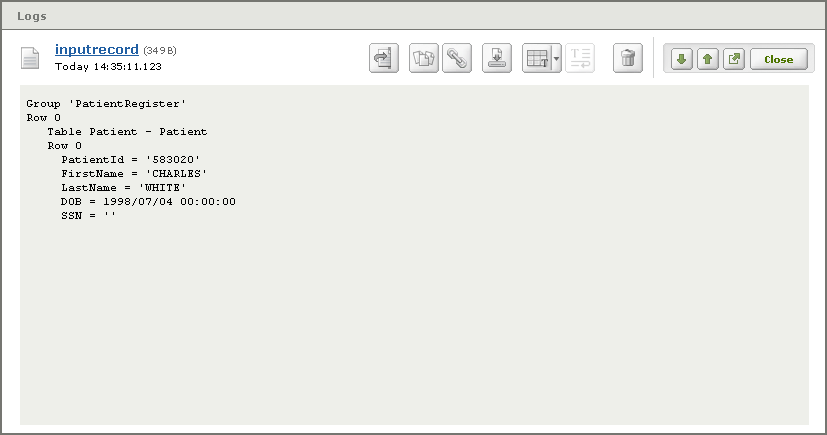

Viewing Table Data Generated From a Message |
If an HL7 message has been logged for a channel that has To Database as its destination component, you can parse the message and examine the database table entries that have been generated for it. These table entries can be displayed in graphical or text format.
To view table data generated from an HL7 message:
- From Iguana, click the Logs tab.
- In the logs, locate the message that you want to examine, and click it. Detailed information on the log message is displayed:

- To parse the message and display the tables in graphical format, select Table View (Graphical) from the view mode drop-down menu:

|
New Feature in Iguana 4.5 The ability to select from a view mode drop-down menu is new in Iguana 4.5. | ||
 |
When you select this view mode, Iguana uses the VMD file that you defined when you configured the To Database component of the channel to parse the message and determine which message definition was matched. The left panel of the Logs screen displays this matched message definition, along with the table grammar for the message definition.
In this example, the message definition is named PatientObservationMsg, and its table grammar consists of two tables, Patient and PatientObservation.

To view the data generated for a table, click its name. The data is then displayed in the right panel of the Logs screen.

If more than one row of table data has been generated from a message, you can view the row location of a specific row. To view this information, click a Row Location link. For example:

In the example shown above, the second Row Location link has been clicked. The Grammar Information window indicates that this line of data is the second PatientObservation table row generated from the message.
| In the Grammar Information window, numbering starts from zero. This means that the first row is labelled Row 0, the second is labelled Row 1, and so on. | ||
 |
- To parse the message and display the tables in text format, select Table View (Plain-text) from the view mode drop-down menu. The table data is displayed in text format:

When you have finished viewing the table data, click Close to revert to displaying the list of log messages.
You can also parse any message sent through a channel if another channel uses this channel as a source and has To Database as its destination component. For example, suppose that an image is sent through a channel named inputrecord. Now, suppose that a channel named outputrecord is created, with To Database as its destination component and From Channel as its source component. If outputrecord's source channel is inputrecord, you will be able to use the database table specified in outputrecord to parse the message sent through inputrecord:

Now, suppose that two channels named outputrecord1 and outputrecord2 are created. Each specifies To Database as its destination component and From Channel as its source component, and each specifies inputrecord as its source channel. In this case, when you display a message sent through inputrecord and parse the message, a list box appears enabling you to select which output channel's data tables you want to use when parsing:
